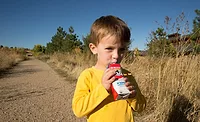Organic Valley discusses the organic milk market and being environmentally-friendly
At the Good Food Expo, Organic Valley’s Theresa Marquez talks about the company's corporate social responsibility programs.

The 2018 Good Food Expo in Chicago gathered together a collection of speakers, chefs, farmers, entrepreneurs, investors, buyers, sellers and consumers who are interested in improving the food system for a better future.
During the event, a regenerative agriculture panel discussion was held regarding the benefits of the practice. The symposium discussed its definition, specific techniques to promote sustainability, biodiversity and carbon sequestration as well as its impact on how consumer packaged goods companies source and make their products.
FE talked with one of the panelists, Organic Valley's Theresa Marquez for more information about CSR programs, Organic Valley’s regenerative agricultural efforts and the organic milk industry.
FE: As consumers become more concerned with how their foods are produced, how important is it for food and beverage companies to make CSR programs a part of their operations?
Marquez: The best businesses today are transparent in all aspects of their business especially social issues. I expect you are asking about gender and racial diversity, minimum wage and benefits, farm worked issues and feeding the poor and hungry. Being socially responsible – either with one’s own program or with B Corp – is good business. Engaged staff with high morale provide the best customer service.
Seventy percent of Millennials say they prefer social and ecologically responsible businesses. Given our age of an increasingly widening gap between haves and have nots, corporate responsibility is growing in awareness and importance.
As a cooperative – we are by structure - 2300 farmers/members own the co-op - what we call “a social experiment disguised as a business.” Our seven member, all farmer board of directors provides governance of the co-op. The staff runs the business and also benefits from profit sharing.
FE: How does Organic Valley work with its growers/suppliers of ingredients?
Marquez: Corporate ecological responsibility is another big theme of our decade. Businesses from Walmart to General Mills to Patagonia are now taking on strategic “regenerative” programs. The new consumer and the old are wanting to see if food companies have values beyond selling food for the lowest price possible.
You can see this through the proliferation of scorecards, initiatives targeted toward saving energy and materials and programs like Carbon Underground’s regenerative agriculture standards.
From a brand positioning point-of-view, it is important. From an economic point-of-view, it is important. Food companies are finding that it pays to conserve energy and water as well as to control waste.
Farming uses 70 percent of our earth’s freshwater to produce food and is a huge contributor to global warming and greenhouse gases especially non-organic farming using nitrogen fertilizers and chemical pesticides. Food waste across the nation is up to 45 percent! The new generations are going to be deeply aware of our social and ecological problems and the new and current generations have heightened awareness of their power in the market place.
FE: How does Organic Valley communicate these activities to consumers?
Marquez: We have a very aggressive media and PR staff with 60 percent of our media resources focused on social and ecological issues. While we sell great quality products, we also want to sell a social and ecological mission and change. We want to have the position of pioneer and leader of food and farm excellence. That means we must support the important social and environmental change issues such as reducing carbon emissions, building soil (the foundation of organic) and increasing perennial grasses as a critical carbon sinking tool.
Another tool to communicate and nurture the good food movement and organic is through our POW (Power of We) programs. We give about $2 million a year away in dollars and food to organizations, non-disaster release and other social and eco programs and issues. Our media team can share with you the millions of impressions we received for our support of solar in Wisconsin. By 2022, our offices, will be 100 percent energy neutral. At present, our wind mills provide up to 80 percent of our needs at our distribution center.
FE: How does Organic Valley’s environmentally responsible approach help with the quality and food safety of your products?
Marquez: Since we represent food from the soil to stomach, strict quality checks from the farm to the plant and even on the truck are essential. Organic agriculture requires the building of soil and the strictest standards for agriculture in the world that must be third party inspected. Once we receive product from the farms we have our own 51 quality checks. From flavor to food safety, we take our responsibility very seriously. Because we are responsible for 2300 family farms it is critical that our consumers know they are getting the highest quality, highest nutritional produce we can possibly produce. See our fatty acid profile studies from 2013 and 2016. We can prove our Omega 3 and Omega 6 quality through over five years of testing and third party analysis.
FE: Right now, milk prices are falling and there have been reports that the organic milk market is in trouble due to consumers switching to plant-based milk. How is Organic Valley responding to this change in the market? How can innovation bring consumers back to milk consumption?
Marquez: Milk consumption and organic milk prices are for sure the topic of the day. Conventional milk has been on a constant downhill slide for a decade or more. The reasons are most likely quite complex covering a wide circle of issues. For example, when I grew up in the 1950s, Mom never let us drink soda, but three glasses of whole milk a day was a mantra! Also, in the 1950s milk was more nutritious because as we have found out from two in depth peer reviewed studies over five years – the higher the pasture the more nutrient dense the milk. Our regular pasture milk which is about 60 percent grass is 63 percent higher in Omega 3s and 40% higher in CLAs (conjugated linoleic acid – high antioxidant) and our 100 percent grass milk is 147 percent higher in Omega 3s. Since only 30 percent of the population eats fish and the body does not make Omegas, this high grass based milk is truly nutrient dense and a super way for young pregnant moms to get Omegas to their unborn and nursing babies and then to their growing children.
Our response to both pricing and the market share falling is to focus on the Brand Organic Valley. While the fluid milk category is dropping – butter and cheese are growing. We are innovating in at least two big areas – first in the area of nutritional density from the ground up. Our 100 percent Grassmilk is achieving incremental sales increase unlike the regular and conventional milk. While it is only 10 percent of our fluid at this time, a study peer reviewed by the Journal for Food Science and Nutrition on Feb 28 confirms when cows eat well so do we.
We’ll be doing Grassmilk cheeses and butter soon. Second is innovation in grab and go and convenience market items to match lifestyles of Millennials. Since we have a meat program, we are launching an all organic cheese and meat snack.
Ingredients category is where our pricing is suffering most from general organic milk oversupply. The brand growth is steady but Ingredient customers are being stolen by competitors not as keen on holding a stable and steady pay price for farmers. We are developing new ingredient strategies and have some hopeful new customers in the pipeline
Regarding plant based competition. I predict that these are trends that, like soy milk, will reach a plateau and then decline. We have evidence that some of these plant based subs have reached their peaks. Regardless, we are doing everything we can to show and communicate to organic customers and the public at large – the nutritional superiority of grass based organic milk.
If we (the milk industry in general) are serious about bringing fluid milk back, the conventional industry needs to drop the CAFO model and go back to pasture. In that way, the milk industry can market themselves as friends of the environment – pasture sinks carbon! It provides habitat for our rapidly dying pollinators. It makes healthier milk in a time when the fish is diminishing especially the fish where quality Omega 3s come from. And sorry to say, a milk mustache is not that meaningful.
FE: Anything else you’d like to comment on?
Marquez: Finally, we will continue to position ourselves as the pioneer and leader of food and farm excellence. We want to be known for having the World’s Second Best milk. We will continue to collect data and send it to third party labs. We will continue to incentivize our farmers to keep adopting more pasture. We will launch a research project studying the possibilities of pasture to sequester/sink carbon. We will show that our programs are helping solve big problems. It is important to note, we are a 30 year organic cooperative. We have watched the industry grow double digit then halt and not grow for a couple of years. We have watched oversupply and then painful undersupply. We expect that this is a roller coaster that will keep going for a while but we are absolutely committed to seeing organic grow and grow. And we hope most livestock will be grass based in the next 10 years.
Looking for a reprint of this article?
From high-res PDFs to custom plaques, order your copy today!







